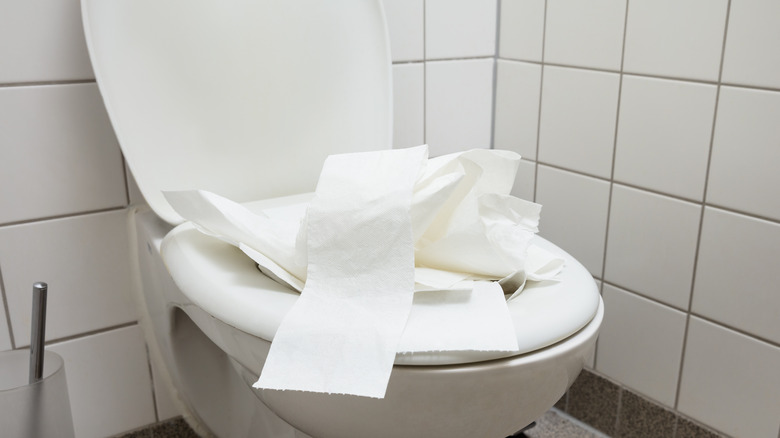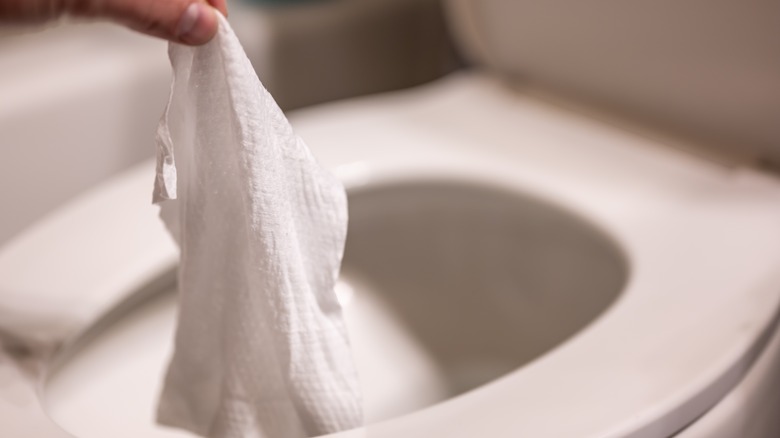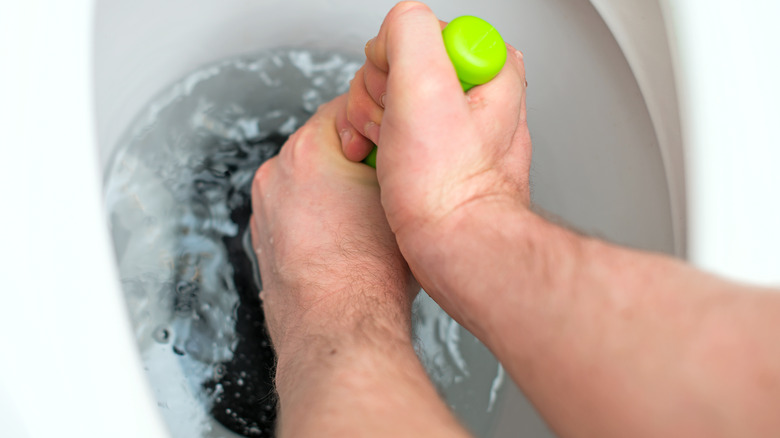How To Test Toilet Paper Alternatives To Ensure A Clog-Free Flush Before Committing
Only the brave dare speak about the direst hour every household has faced — an urgent intestinal need when there's no bathroom tissue available. These moments of desperation breed innovation as we consider baby wipes, tissues, sanitary pads, and even coffee filters as toilet paper alternatives. But how can you be sure these options won't lead to clogs and costly repairs?
Before committing to a new variation, take some time to investigate thoroughly before you end up with a potentially smelly surprise. With the "shaken and stirred" test, the "flush test," and the "jar test" at the ready, you may always have a potential TP alternative when you're in a bind. In case you're not one for toilet experiments, we have a handy solution that will give you instant answers, too.
Unless you're confident that your wipe option will flush cleanly, you may need to learn how to use a toilet plunger to get an efficient flush, and that may be too much trouble if you've forgotten to stock up on your family-sized pack of tissues. Traditional toilet paper rolls are designed to break down quickly in water, which helps prevent clogs, but there is no such guarantee with bathroom tissue substitutes. According to a study published on Research Gate, the physical disintegration of flushable consumer products (such as tampons and baby wipes) varies significantly, and some items are more prone to cause blockages in the wastewater system. Therefore, it's better to know what you're dealing with ahead of time, because otherwise, you'll never know what you've got until it's (not) gone.
Test the bathroom tissue alternative with a jar and water
You don't have to be James Bond to try out the "shaken and stirred test." Use this method if you're testing several TP options to compare how each may react when you dispose of it in the toilet. Gather some jars, water (it's not a martini, folks), and a stirring stick. Then place the tester samples in the water jars and stir several times. Wait an hour (or a little less, if you're short on time), then stir again. After letting the substitute toilet paper rest for another hour, you're free to shake the solution and determine which alternative tissue disintegrated the best.
For the "jar test," fill a jar with some water, add a toilet paper roll alternative, seal it, and shake the mixture well for about 10 seconds. In other words, we're trying to simulate the treatment the flushed wipe will receive, but on a smaller scale. If the paper breaks down within a few minutes, disperses, and does not clump together, it's likely to be a safe choice for your plumbing. This method helps you gauge whether the paper will dissolve quickly enough to prevent clogs. It's also faster than the previous test, especially if you're pressed for time.
Both of these approaches are handy for testing the stand-in TP before introducing it to your plumbing system. But if you're already in a sticky situation with the substitute clogging your plumbing, there's a solution that can make your problems (quite literally) disappear.
Treat a backed-up toilet with enzymatic solution
Perhaps you didn't have the time to run a pre-test of your toilet paper alternative, so you took a chance and flushed, and your plumbing system is backed up and threatening to overflow. Now what? A bio-enzymatic treatment may help dissolve paper waste while still being eco-friendly, unlike a lye-based product like Drano, which plumbers warn consumers to avoid.
One such product is Bionetix International's Paperator, which "eats" the cellulose in flushable paper products and assists in making them biodegradable. The Paperator also shows impressive results when "digesting" kitchen towels, loo paper covers, and even 3-mm-thick pieces of cardboard. To help unclog blocked toilets, drop one of their dissolvable pouches into the bowl and allow it to sit for up to an hour. Afterward, flush as usual.
If you don't have an enzymatic product immediately available, you may have to turn to the trusty plunger or an auger if your toilet trap becomes clogged. Alternatively, before calling a professional plumber, you could also try using shampoo to unclog your toilet. The shampoo, or even dish soap, acts as a lubricant, helping the clumped-up material to dislodge quickly and flush away without much fuss.
The bottom line is to prepare yourself for toilet paper emergencies. While you may not always have the bathroom staple on hand, you need to know what other options you could safely rely on. But, if at first you don't succeed — please don't flush again.


